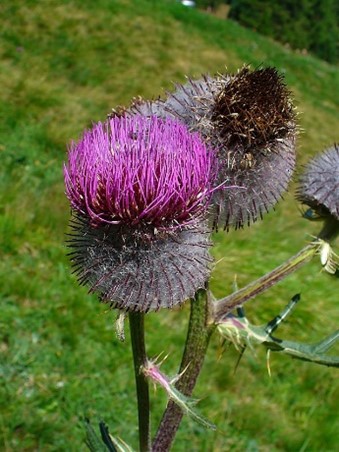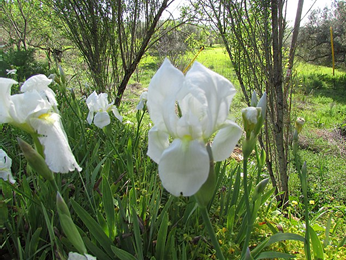Previous Lectures Sep 2021 – June 2022
Previous Lectures Sep 2020 – June 2021
Previous Lectures Sep 2022 – June 2023
February 15 2024
Art Behind Bars
By Angela Findlay

Angela’s knowledge as an artist, teacher in prisons and Arts Coordinator to the leading prison charity Koestler Arts has resulted in her developing techniques to help educate prisoners. She showed stunning slides which helped illustrate how underlying issues in prisoners’ lives could be addressed through art. One issue was the overstepping of boundaries which she explored with prisoners through the colours yellow, red and blue. In groups inmates were asked to communicate with each other only through the use of the colour they were given by painting on paper. When someone went into another person’s space on the paper with a different colour, they were asked how that felt and then they would relate those feelings to how the person felt who they had committed a crime against. Other issues covered included the idea of a quick fix mentality when a crime is committed for instant gratification. Angela led projects involving time consuming stunning outdoor mosaic displays which gave the prisoners self-esteem. Other amazing art works were shown to address the issues of a lack of an authority figure in a prisoner’s life and the issue of emotional illiteracy when a person is constantly reacting to situations. Slides of art ranging from cartoons to harrowing self-images were explored to show that prisoners can learn life skills through art.
18 January 2024
Murder Most Florid
By Mark Spencer


Inspired by the gift of a book called “The Concise British Flora in Colour” by the Reverend William Keble Martin, Mark explored the wonderful world of plants and how they can help the police solve crimes. Beautiful slides of plants, flowers and landscapes accompanied a fascinating talk about Mark’s career as one of only two United Kingdom Forensic Botanists. A bed of brambles, a pillow of ivy and an Ash tree helped Mark solve one crime. He explored famous crimes such as that of Charles Lindbergh in which the tracing of a special wood from a specific tree in a particular area was the defining factor in prosecuting the criminal.
Rubus Fructicosus – the common bramble – is one of Mark’s favourite plants and the position and colour of this plant at a crime scene can help determine when a crime was committed. Pollen from the fuchsia woolly thistle is insect-borne so if that is found at a crime scene it will not have travelled far. An unusual slide of the attractive shapes of Diatoms made of silica was shown as these are used to determine whether or not drowning was a cause of death. He concluded with a stunning slide of the white iris which has been spread all over the world from Southern Spain due to its connection to Islam.
| December 7th 2023 From Cradle to Grave: The Iconography of the Nativity in Late Medieval Italian Art. By Helen Dejean  The Stradfas Christmas lecture was celebrated by Helen Dejean talking to members about eighteen hundred years of the iconography of Christ. She explored the nativity iconography in the East and how Italians viewed the art until it eventually became reproduced for Christmas cards. Icons are devotional images through which the viewer and Holy subject matters make contact. They were intended to instruct. Beautiful slides displayed icons by Duccio from 1305 showing the life of the Virgin. The artistic style is a fusion of Western Gothic and Byzantine, and the subject matter is the Birth of Christ. Helen explored the different images in the icons such as the cave, the Virgin Mary lying down, the Ox and Ass and an altar crib, with the baby in swaddling clothes. Thus, it shows traditional imagery in telling the story but in a new style. Two gospel writers, Luke and Matthew, told the story in such a way that icon painters could easily reproduce the images in paintings, and Helen illustrated this by reading a passage from Luke 2 verses 4-8 about Joseph going into the city and showed how this story was depicted in an icon. The old law as shown in the style of Giotto looks more like a stage set: there is no cave, there is a lean-to construction, the virgin is sitting up and Joseph is shown at the side. With the coming of the Black Death in 1346-1353, images changed. By the end of the 14th century, there was a cave in the icons. The cave was suggested to have come from the idea that Christ was supposed to have been born in a hollowed-out cave over which the basilica in Jerusalem was built. The virgin is sitting up, the Christ child is lying on the ground and Joseph is at the side. Northern European Renaissance painters were influenced by iconic art, and so, this art, together with the influence of the visionary Saint Bridget of Sweden, has combined to help form the modern day religious images on Christmas cards. |
November 16 2023
The Culture of the Ukraine
By Rosamund Bartlett

The history and geography of Ukraine was skilfully interwoven with examples of art, music, dance, architecture and embroidery so that its culture could be understood. The lecture centred around Lviv, Kyiv, Odessa and the Cossacks who were originally itinerant groups in the North. Ukraine is now multi-ethnic and multi faith.
Ukraine and Russia were originally one country but when the people of Kyiv were searching for their own religion, they settled on the beliefs around the Hagia Sophia Mosque in what was then Constantinople, as it had beautiful singing and wonderful mosaics. The Greek monks taught reading and writing and translated the gospels. We were shown beautiful icons and mosaics in the cathedral. Music as another part of the culture was explored and we were treated to a video of the singing of a Dumas – an epic song – about the river Dnieper – accompanied by the playing of a Kobka which is a multi-stringed lute. The Kobka was originally played by itinerant Ukrainians during the Hetman era.
A talented painter, Taras Shevchenko, born a serf in 1814, became the great national poet of Ukraine and we heard some of his poetry about the Russian motherland. Another aspect of Ukrainian culture, dance, was displayed in a film of some very energetic Cossacks dancing a Hopak! The famous painting by Ilya Repin entitled “The Reply of Zaporozhian Cossacks to the Turkish Sultan” painted between 1880-1891 was explored showing the Cossacks’ response to the Sultan demanding acceptance of the Turkish rule. Ivan Mazeppa was one of the last great Cossack leaders and he began to restore religious buildings including the Church of the Assumption in Kyiv. He introduced the Baroque style.
Peter the Great founded St. Petersburg to which many artists and musicians migrated and one such painter was Dimitry Levitsky who was born in Kyiv and became a great Russian portrait painter. Catherine the Great extended the borders of the Russian Empire to include Kiev and she was a patron of the arts and literature.
Colour is at the heart of much of Ukraine’s culture even today, whether it be in painting on houses or embroidered shirts and family icons, where flowers or geometric designs symbolise the journey from earth to heaven. A triangle symbolises the Holy Trinity and a diamond pattern symbolises fertility. Ukrainian as a language was recognised in 1917 although Ukraine was not legitimised as an independent country until 1991.
| October 19 2023 Tamara de Lempicka – Art Deco Diva By Alexandra Epps  Alexandra Epps delivered another memorable lecture, about Tamara de Lempicka the Art Deco Diva who re invented herself so many times in order to survive. Born in Warsaw around the time of 1898 into a life of privilege, she went on art tours with her grandmother as a young girl and wintered in Petrograd. Whilst there she absorbed the culture which influenced her art. In 1916 she married a lawyer but when the Bolsheviks took over, she had to flee to Paris with her daughter. In order to survive they initially lived off the proceeds of the sale of jewellery she took with them. She trained as an artist under the guidance of Andre Lhote who was a pioneer of Cubism, and his influence can be seen in “Rhythm” painted in 1924. The figures have longer more sweeping backs than Lhote produced, and she has softened them using light across their bodies in a similar way to Caravaggio. “The Pink Tunic” is of a woman looking at the viewer, supposedly waking up to her own sexuality, in the style of Raphael. In Milan she painted portraits of men including “Marquis D’Afflitto” with a tiny waist, broad shoulders and in a similar pose to Botticelli’s “Mars.” Her famous “Auto Portrait” of herself driving a green Bugatti with her initials on displays her steel eyes possibly signifying determination as driving at that time was considered to be a male activity. She had many affairs with both men and women, such as Suzy Solidor who was the first female owner of a Parisian nightclub. She displayed Tamara’s paintings on the stage and so more of her portraits were sold. Her painting of the Duchesse de la Salle in 1926 in a riding habit shows a very different kind of woman from other portraits of the time and her silhouette was used in an advert for Gitanes. Her first husband left her, and she later settled in New York as a baroness where she painted more in the Baroque style. A magazine article written about her in 1967 rekindled interest in her work and her designs were used on paperback book covers. Armani dedicated a fashion show to her, and she modelled for Van Cleef and Arpels. In 2019 a painting of hers sold for 22 million dollars. |
| September 21 2023 Bruegel: The Seasons and The World By Gavin Plumley The Hunters in the Snow by Pieter Bruegel the Elder 1565in the Kunsthistorisches Museum in Vienna.  Beautiful slides and a wealth of knowledge and information delivered in a light-hearted way resulted in in a fascinating lecture about Bruegel the Elder. Some of the Six Seasons paintings commissioned by Nicholas Jongelinck were explored in depth. They were painted in oil on wood panels and were probably adorning the walls of his dining room in Antwerp in 1565. “The Harvesters”, representing July and August shows the stooks of wheat piled high to avoid the damp, a drunken man lying down and another man emerging from the wheatfield. On the horizon is a solar eclipse! “The Return of the Herd” representing Autumn depicts rain clouds but in the foreground is a white dappled cow showing how important the arrival of the herd is to the people’s survival of winter. The lead white snow in “The Hunters in the Snow” illustrates just how terrifying winter is to ordinary people with the mill wheel frozen so that no work can be done and a fire in a chimney being extinguished with the snow. In all the pictures there is something to remind us of our own short tenure on earth such as gallows or a scythe representing the Grim Reaper. Other paintings were shown, and fascinating facts were given about the whereabouts of the existing paintings, the inspirations and influences on them interspersed with anecdotes about Gavin’s own life and home. However, he ended on a note of caution by warning that Bruegel the Elder showed us through his paintings that he understood that we are not in charge of nature but mere custodians of it and we ignore the rules it sets at our peril. |

